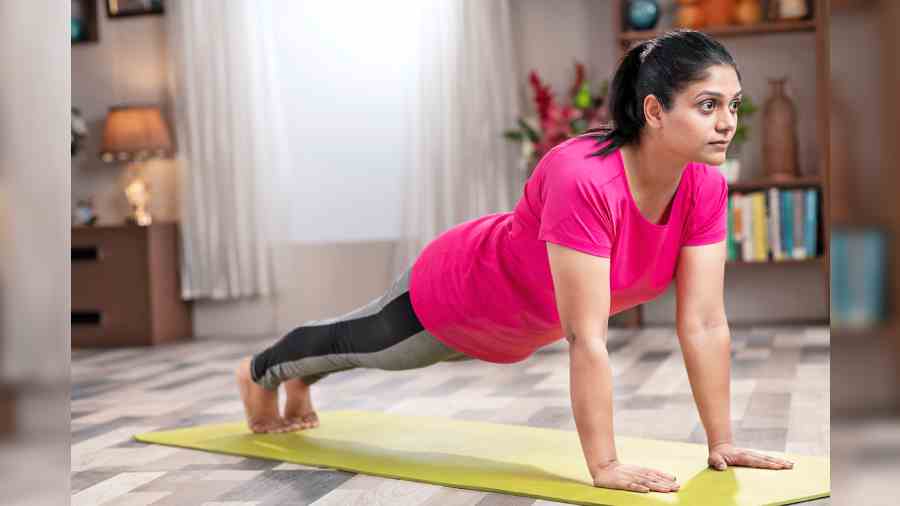A large study from 2019 found that r e p l a c i n g 3 0 minutes of sitting each day with moderate to vigorous physical activity was associated with a 45 per cent reduction in mortality risk. And many other studies have found that short, intense workouts two to three times a week can improve lung function and cardiovascular health.
Experts from the US Centers for Disease Control and Prevention recommend that most adults should get 150 minutes of moderate-intensity exercise each week, but you can cut that in half, to 75 minutes a week, if the workout is intense.
Stephen J. Carter, a cardiovascular physiologist at the Indiana University Bloomington School of Public Health, US, said that shorter, more intense workouts are better than longer, less intense workouts at lowering the risk of cardiovascular disease and reducing overall mortality rates.
Maillard Howell, head of fitness at Reebok and co-owner of Dean CrossFit in the New York borough of Brooklyn, said the key to getting an effective workout in a short amount of time is focussing on what is called compound exercises.
A compound exercise is one that uses multiple muscle groups at the same time to perform a movement — like squats, push-ups or deadlifts. Isolation exercises, like bicep curls or calf raises, won’t raise your heart rate as quickly as compound exercises and primarily work one muscle group at a time.
If you’re short on time, “you want big movements that use big muscles,” Howell said.
When you use multiple muscle groups, your body shunts blood away from the organs to the working muscles, Carter said, which ultimately raises your heart rate.
Taxing your heart like this two or three times a week can bring a host of cardiovascular benefits, Carter said, including a decreased heart rate (which is a sign of a healthy heart) and lower blood pressure.
In addition to compound movements, the other secret to making a short workout effective is minimising rest time between exercise reps and when transitioning between movements, Howell said.
How should you prepare?
With any workout, Howell said that it’s essential to start with a warm-up and end with a cool down. But for a 20-minute workout, your warm-up will have to be extra efficient.
Carter recommended a three to five-minute warm-up with the goal of increasing your circulation. Howell likes to do what is called the cat-cow yoga pose, where you start on all fours and arch your back and look up at the ceiling, then round your back, dropping your head between your shoulders. Repeat this movement about 15 times, until your body starts to feel looser, then move on to some jumping jacks and high knees, where you bring your knees up to your chest one at a time, either by marching or running in place.
What should your workout be?
One of Howell’s favourite workouts is: five body weight squats, five push-ups and a 30-second plank — repeated six times, resting for no more than 30 seconds between rounds. If you can’t do a push-up on the floor, do it against a countertop or a stable bench. You can modify the plank by putting your knees on the floor or doing a standing plank by placing your forearms on the wall.
If this is easy for you, Howell said, you can ramp up the intensity by trying 10 squats, 10 push-ups and a 60-second plank — repeated 10 times. If you have access to a dumbbell or kettlebell, Howell suggested throwing them into the mix. You can change the body weight squats to goblet squats, holding a kettlebell or dumbbell in both hands at chest level as you squat. Set a timer for 20 minutes and try doing 15 goblet squats, 15 kettlebell or dumbbell swings and five minutes of running on the treadmill (or around the block) at a moderate pace. Repeat this routine until the 20 minutes are up.
How should you end?
Once you’ve completed the workout Howell suggested a three to four-minute cool down. He recommended static floor stretches, like the pigeon pose — with one leg stretched out straight behind you, and the other bent in front with the side of your calf resting on the ground. You can rest your calf up on a bench to make it easier, or just go through any stretches that feel good.
Remember to keep challenging yourself. After a few weeks, try a slightly heavier weight, more repetitions or perhaps a more challenging version of the movement.
“You’re not going to get all the good stuff that comes from exercising if you keep doing the same thing at the same weight all the time,” Howell said, “so start playing around with maybe something a little heavier and go from there.”
NYTNS











